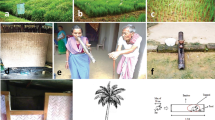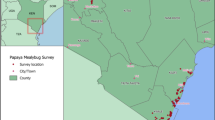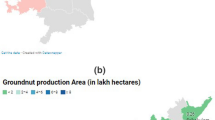Abstract
A study was conducted in Muswishi area, Zambia, with the objective of assessing indigenous technical knowledge (ITK) and relating this knowledge to integrated pest management (IPM) in maize production. The methods used included surveys, participatory rural appraisal (PRA), transect walks and semi-structured interviews (SSI). It was found that ITK does exist among some Muswishi smallholder farmers. Eighty-nine percent of respondent farmers never used any chemical pesticides. However, 22% used natural products to manage insect pests. The most widely used natural plant products were Swartzia madascariensis Desv, Tephrosia vogelli Hook.f, Euphorbia tirucalli L, wood ash and cow dung. Farmer’s own assessment indicated that the integration of ITK into IPM technology led to increased maize yields (> 37.5%). This study demonstrated the continuing need for integrating ITK into IPM technology. Such an approach could ensure household food security and enhance sustainable livelihoods of rural smallholder farmers.
Résumé
Une étude a été réalisée dans la région de Muswishi, en Zambie, afin d’évaluer les connaissances techniques indigènes (CTI) et de voir dans quelle mesure celles-ci pouvaient être intégrées dans les pratiques de Lutte Intégrée contre les insectes nuisibles (LION) du maïs. Les méthodes utilisées consistaient en: (i) enquêtes-sondages; (ii) évaluation du niveau de participation des petits fermiers en milieu rural, (iii) marches en transects; (iv) interviews semi-stucturées. Les résultats obtenus ont montré que certains petits fermiers de Muswishi possédaient bel et bien des CTI. De cette enquête, il ressort que, pour lutter contre les insectes nuisibles, 89% des fermiers n’ont jamais eu recours à aucun pesticide de type industriel, tandis que 22% ont utilisé les produits naturels dérivés des plantes. Parmi ces produits, les plus couramment utilisés étaient à base de Swartzia madascariensis Desv, Tephrosia vogelli Hook.f, et Euphorbia tirucalli L, ainsi que la cendre et la bouse de vache. Cette étude a révélé que l’intégration des CTI dans la technologie de LION a permis d’accroître de plus de 37,5% par parcelle de 0,25 ha la production de maïs. Elle a prouvé que les petits fermiers en milieu rural ont un besoin constant d’intégrer les CTI dans la technologie de LION. Une telle approche devrait permettre d’améliorer la sécurité alimentaire et les conditions de subsistance des petits fermiers en milieu rural.
Similar content being viewed by others
References
Aagaard P.J. (ed.) (1997) Conservation Farming Handbook for Smallholders in Regions 1/2. 54 pp. With the support of Integrated Crop Management Food Legume Project (FAO) Conservation Farming Unit July 1997 (Zam/92/003) First Edition.
Anandajayasekeram P., Dixon J., Ebong C., Lungu O., Mbuyab J. N., Nyoni D.M. and Torkelson A. (2001) A Sourcebook for FSA in Farmer Training Institutions. FARMESA, Harare, Zimbabwe. 120 pp.
Altieri M.A. (1995) Agroecology. The Science of Sustainable Agriculture. 2nd Edition. Westview Press, Boulder. 433 pp.
Chambers R. (1991) Scientists or resource-poor farmers: Whose knowledge counts?, pp. 1–15. In Proceedings of a Seminar on Crop Protection for Resource-Poor Farmers. 4–8 November 1991, Isle of Thorns Conference Centre, East Sussex, UK. (Edited by J. Gibson and A. Sweetmore). CTA, The Netherlands.
Flint M.L and Van den Bosch R. (1981) Introduction to Integrated Pest Management. Plenum Press, New York. 240 pp.
Fliert van de E. (1998) Integrated pest management: Spring board to sustainable agriculture, pp. 250–266. In Critical Issues in Insect Pest Management (Edited by G.S. Dhaliwal and E.A. Heinrichs). Common-wealth Publishers, New Delhi.
Fliert van de E. and Proost J. (eds) (1999) Women in Agriculture: Crop Protection Practices and Strategies. Royal Tropical Institute, KIT Press, Amsterdam, Netherlands.
Hanyoma S. (2001) Farmer Field School: Classrooms without walls. Ground up. A Pelnum Publication Promoting Sustainable Communities. Vol. 1 (5), 26.
Kaposhi C.K.M. and Phiri P.S.M. (1999) Inventory of local plants with pesticidal, repellant and medicinal properties in the Muswishi Lusitu areas. FARMESA Terminal Report. 38 pp.
Masi C. and Bangwe L. (1998) Diagnostic and planning study in Muswishi Field Site of Chibombo District, Central Province, FARMESA. Ministry of Agriculture, Food and Fisheries, Lusaka, Zambia.
McCall M. K. (1995) Indigenous Technical Knowledge in farming systems of eastern Africa: A bibliography. Division of Social Sciences ITC. Enschende The Netherlands.
Njovu C. (1998) Compilation and assessment of locally adapted and new promising field methodologies for technologies development and transfer for smallholder farmers in Zambia. FARMESA Document 98/11.
Nkunika P.O.Y. (1999) Implementation of integrated pest and disease management strategy for smallholders in Muswishi area of Chibombo district, Central Province. FARMESA Terminal Report.
Nwanze K.F. (1997) Integrated management of stemborers of sorghum and pearl millet. Insect Sci. Applic. 17, 1–8.
Ortiz O. (1999) Understanding interactions between indigenous knowledge and scientific information. Indigenous Knowledge and Development Monitor 7, 7–10
Van den Oever R. and Segeren P. (1997) Pest and disease management in irrigated maize and IPM technology transfer to smallscale farmers in southern Mozambique. Insect Sci. Applic. 17, 297–303.
Van Huis A. and Meerman F. (1997) Can we make IPM work for resource-poor farmers in sub-Saharan Africa? Int. J. Pest Manage. 43, 313–320.
Author information
Authors and Affiliations
Corresponding author
Rights and permissions
About this article
Cite this article
Nkunika, P.O.Y. Smallholder Farmers’ Integration of Indigenous Technical Knowledge (ITK) in Maize IPM: A Case Study in Zambia. Int J Trop Insect Sci 22, 235–240 (2002). https://doi.org/10.1017/S1742758400012108
Accepted:
Published:
Issue Date:
DOI: https://doi.org/10.1017/S1742758400012108
Key Words
- smallholder farmer
- maize
- integrated pest management
- indigenous technical knowledge
- natural plant products
- food security
- Zambia




